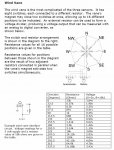Thanks Folks. Sorry it's a few days since I checked this thread. Things have gone well, with testing of our picaxe based autopilot on Bray Lake. I've updated my robot boat page
www.gpss.co.uk/autop.htm but that's mostly to update some links and add the fantastic picture of the French boat (about 1.4 metres long) braving the Atlantic waves. Latest news is that also broke (front sail) and is drifting back towards France. The only other serious attempt was by the Welsh Team a year ago - that was last seen 60 miles west of Ireland - but also broke. The rest of us, including teams around the World, are still testing their solutions.
On Bray Lake I've concentrated on testing the basic robot boat #6, without instrumentation (too heavy), programmed to steer back to the same waypoint from anywhere on the lake. We are about to try with it programmed to sail to waypoint Delta, a hundred metres out, then back to Base again. We are still working on water-proofing!

I've also ordered what looks like a good Hall effect direction sensor chip from Switzerland: the Ametes 360-ASMC-01. It seems to have two outputs: analogue - that we can use directly, and PWM (Pulse Width Modulation) - not difficult to measure with a loop taking maybe 1000 samples on the input pin. This sampling method may drift less in accuracy with temperature and supply voltage (between 3v and 5.5v depending on sunshine). I've ordered two chips, and hope to be testing soon. When we have a wind direction sensor on the boat, I can modify the picaxe software, and the boat may then be ready to try the total Bray Lake course, including tacking into wind - as did boat #5.
Boat #6 is only 3 ft long (less than a metre) and we've not found it big enough for the extra weight of test bits (seen on my robot boat page) so we have cut it down to the basic boat - more similar to how it might be used. However, next sail, it will probably carry a little GPS logger, for later analysis of how well it steered to waypoint D and back.
It has occured to me - but not TOO seriously - if it might be easy to make a second PICAXE test module - that talks to shore, as does our iPAQ based solution. On the iPAQ (seen and heard in the "Snoopy Sails!" video) the software speaks things like distance and direction to waypoint, and the sound is passed to an FM transmitter (similar to as used in a car to link ipod to car radio) to carry the speech to a tranny radio with us on the shore. It's also good to hear things like speed.
The picaxe autop1.bas application already sends info as text to the jack plug connected to the PC during use of the picaxe editor. How about if this serial output went to a second picaxe system, with text to speech (which I saw somewhere is available) to pass sound to the FM transmitter ?
I've got plenty to get on with for now, but any ideas on this might make me take a closer look.
Thanks for your good suggestions in the past - they often save me time.
Robin
www.gpss.co.uk
